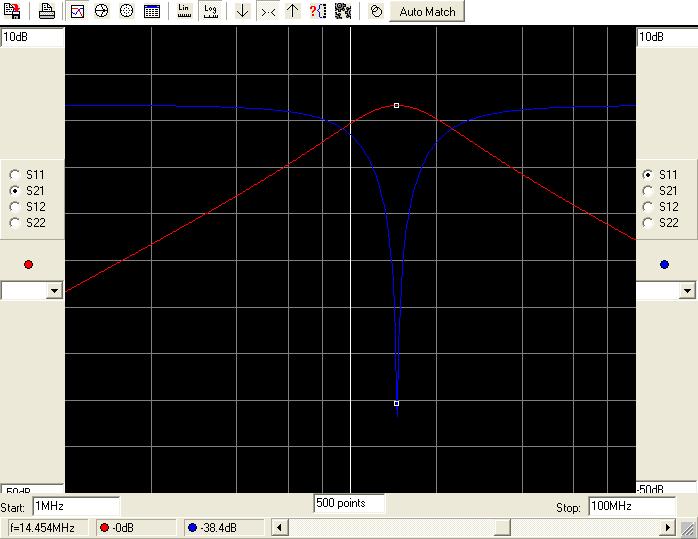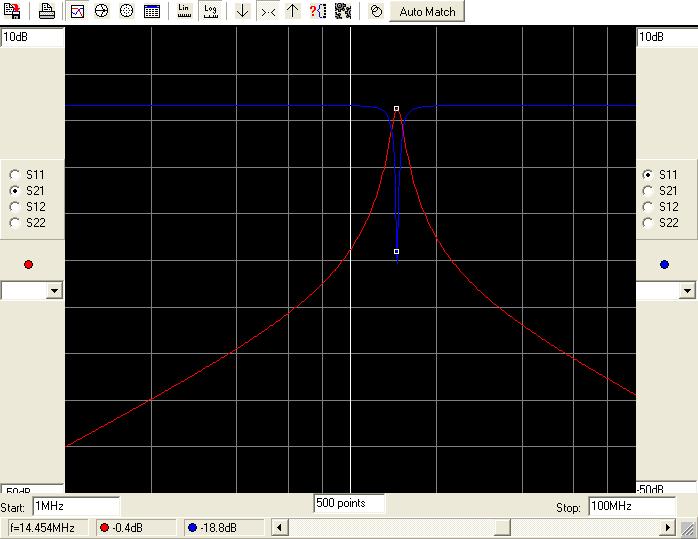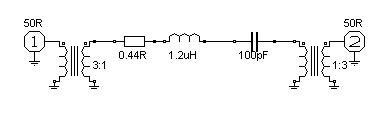ANICETUS
ANICETUS (Anie) - Preselector - a few designs for narrow band preselectors
Ideas, comments and suggestions are welcome.
73's Phil...VK6APH
Whist the jury is still out as to whether most users need some form of filtering before receivers that do Digital Down Conversion there will be situations where strong signals will overload the ADC.
Some of these situations will be rectified by using a simple High Pass or Low Pass filter before the ADC. The HPSDR Alex project was developed for this purpose.
For some users overload from local Medium Wave broadcast stations can be resolved with the addition of a simple HPF before the receiver.
Where strong signals are either in-band or adjacent to the wanted signal then some form of tunable preselector will be necessary.
A simple and efficient preselector can be built from a series tuned circuit as below.
At resonance [f = 1/(2piLC)] the circuit will have a bandwidth determined by the overall Q of the circuit. Considering the inductor alone, if we assume a Q of 200 as being practical then we get bandwidths of (BW = f/Q) of
160m 1800/200 = 9kHz 10m 28000/200 = 140kHZ
To keep things simple we will base our math on the 20m band in which case the BW becomes
20m 14000/200 = 70kHz
Suitable values for L and C at this frequency are L = 1.2uH and C = 100pf.
Using an appropriate toroidal inductor at this frequency should enable us to realize a Q of 200. In which case the equivalent loss resistance of the inductor becomes
R = Xl/Q = 2xpix14e6x1e-6/200 = 0.44 ohms
So the equivalent circuit now looks like
OK - so now we place our tuned circuit between the antenna socket and the input of the receiver. For modeling purposes we can assume an 50 ohm antenna and receiver input impedance.
In which case our model looks like this
And the frequency response thus:
Something does not look right here – our 3dB bandwidth is about 14MHz, not 70kHz? What has degraded our Q so drastically? Well it turns out that the 50 ohms of our antenna and receiver input appear in series with the inductor. So our Q is now
Q = 2xpix14e6x1.2e-6/(50+50) = 1
In order to improve the selectivity we need to reduce the input and output impedances. Let assume we can reduce them from 50 ohms down to say 5 ohms. This increases our effective Q to 10 and results in the following selectivity curve:
The 3dB bandwidth is now 1.4MHz - much more useful.
In practice we can use a transformer at the input and output of our preselector. In order to minimize losses a 3:1 turns ratio (9:1) impedance transformer at each end will reduce the impedance to 50/9 = 5.5 ohms.
A simple, practical, preselector can then be built as follows:
Tuning is obviously manual, you need to select the correct inductor value and adjust the capacitor each time you change frequency.
From a practical perspective we need to use a physically large toroidal core to wind the inductor on. In practice I’ve found that even using a T300A-2 core there is a slight degradation of IP3 at the +50dBm mark when used with Mercury.
Similarly, the input and output transformers must be carfully selected so as not to degrade the overall performance.
I should add that measuring IP3 at his level is not straight forward and I needed to build special test equipment in order to do these tests.
It looks like others have found the same issue; this is a photo of the preselector used in the very high performance Hilberling PT-8000 receiver.
They have an interesting way of selecting the taps on the inductor by placing the relays inside the core.
Whilst a manually tuned preselector is useful it would be nice if the device automatically tuned itself based on the frequency the receiver is tuned to.
This is the approach used by Peter, HA5RXZ, in his design; a partial schematic of his preselector is shown below.
In order to tune the preselector to the receiver frequency Peter uses a STAMP uP to measure the receiver local oscillator frequency and select the required relays. Not shown in the above diagram are the driver circuits for relays 7 to 14 that control the selection of the series capacitance via a binary sequence.
Initally programming the correct combination of relays will be an interesting software issue.
For use with HPSDR we could use an I2C or SPI connected relay driver chip to control the relays. By using Penelope to generate a test signal the system could step across the HF bands and automatically learn which relays to operate on any particular frequency. In this respect the system would be self calibrating.
There are a number of commercial preselectors that are based on the above principles. These include:
- https://web.archive.org/web/20100126034937/http://www.m0wwa.co.uk/page/scrpreselector.html
- https://herostechnology.co.uk/pdf/M0WWA_SCR_Preselector.pdf
- https://web.archive.org/web/20101020042250/http://www.m0wwa.co.uk/page/M0WWA_projects.html
Here is another idea by YU1LM
Feedback
Comments from Steve VK6ABZ
As this is an area where I've had some design experience, I look forward to seeing the preselector notes on the wiki and hope I can make a useful contribution. Most of my experience has been with pre/postselectors for marine applications where simultaneous transmission and reception has been' required. Obviously the scope for separating the transmit and receive antennas is limited on a ship! I hope the following is useful.
The units I worked with had to provide at least 30 dB of attenuation at 5 % frequency separation with an IP3 of at least 55 dBm (5/10 %). This was achieved with two pairs of coupled resonators with an amplifier in between to compensate for the losses. Tuning was by means of reed-relay switched capacitors for speed and automation (note that in standard reed relays the RF resistance is too high for this application). Ganged variable caps or fixed tuning would perhaps be more appropriate for an amateur application.
The coils were initially solenoidal (pie-wound for the low bands) with iron powder screw cores for adjustment but good performance was later also obtained with the L57 'cup and screw core' formers from Lodestone Pacific. These latter formers have the advantage that they are screened. The cup and core are made of iron powder, either carbonyl E for low frequencies, or SF for high frequencies. Iron powder was found to give much better intermodulation performance than ferrite and it did not drift much over temperature. In order to get the best Q at 1.5 - 3 MHz stranded silk covered wire had to be used. An enormous number of strands seemed to be needed for best performance. Litz wire would probably be best but I don't think it's easy to obtain these days. I never really tried iron powder toroids due to the difficulty in tuning them on a production line but I imagine they would give good performance and can be tuned by bunching up or spreading out the turns. The use of high Q solenoidal coils demands excellent overall screening and filtering in the unit to keep out switch mode noise etc. In this respect they appear to make excellent receive antennas! I had to fit two of these units in the same drawer as a switch mode PSU but reckon the effort took several years off my life!
To maintain a good filter response and insertion loss, both loading and coupling of the resonators have to be maintained across the band. Not too difficult over 1.5 octaves or so.
If transformers are required ahead of the filters, high permeability ferrites introduce less IMD. I found that the monolithic ceramic plate capacitors of the NP0 and N150 etc grades introduced unacceptable IMD but never worked out why. Multi layer COG ceramics appeared to be the best ceramic types; better even than silvered mica in this respect. Keep in mind however that I was looking for a level of IMD performance that most land based systems would never need. These effects are relatively minor.
When it comes to measurement of the intercept point of a preselector, I agree that it is challenging. The dynamic ranges involved stretch the capabilities of a spectrum analyser to the limits. Even if a hybrid combiner with isolated input ports appears to give good results on a spectrum analyser, it may produce worse than expected results when connected to a preselector. The reason for this is that a spectrum analyser has a broadband matched input but the preselector will totally reflect the out-of-band test signals back into both signal generators where they will often happily intermodulate. The best way around this I found was to start with as good a pair of signal generators and hybrid as possible and then to place a sharp notch filter before the unit under test. It is possible to make notch filters that can be tweaked to provide perhaps 50 dB or more of rejection at the notch frequency, thus rejecting the intermod product generated by the signal generators and hybrid, whilst presenting a 50 ohm termination at both ports. These filters were a bit tricky to set up and would go off tune if breathed on but just needed to remain stable for the duration of the measurement. The filters used comprised a parallel RLC circuit in series with the signal path with a series RLC to ground from a centre tap on the parallel circuit. It's a sort of bridge that has theoretically infinite attenuation at the notch frequency if everything is balanced.
Just a final point. Spare a thought for the humble attenuator. For transmit you need as efficient an antenna as possible but for receive it only needs to bring in enough signal to bring the external noise (atmospheric, man-made, galactic etc.) to just above the receiver's noise floor. Much more than this will exacerbate intermodulation problems.
Suggestion from Graham, KE9H
Use two switched 4:1 transformers at the input and output. I was thinking of 4:1 at the low end of the band, to widen out the bandwidth at 160 and 80 Meters, so the panadaptor is still useful, and switching to 16:1 for 40 Meters and upwards for maximum selectivity.
Implementation would be two 2:1 (voltage) transformers in series, that were relay switched so that they could be selected for driving the series resonant circuit at either 12.5 Ohms or 3.125 Ohms.
The schematic below shows how this would be implemented
Why Anicetus (Anie)?
Alexiares and his twin brother Anicetus - were the Greek Gods of Defense, in particular the defense of fortified towns and citadels.
Both were sons of Hercules (Herakles), born after the Hercules' ascension to Olympus and his marriage to the goddess Hebe. Alexiares and Anicetus helped serve as the gatekeepers of Olympus, assisting their father in a role which was commonly assigned to him.








